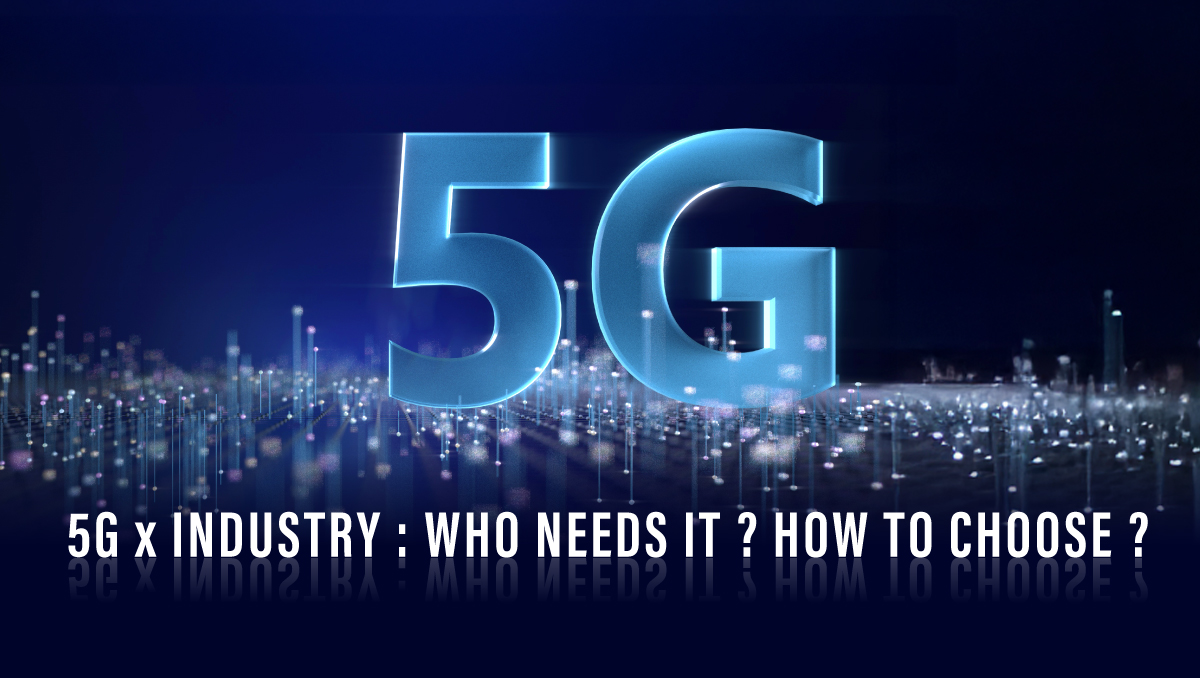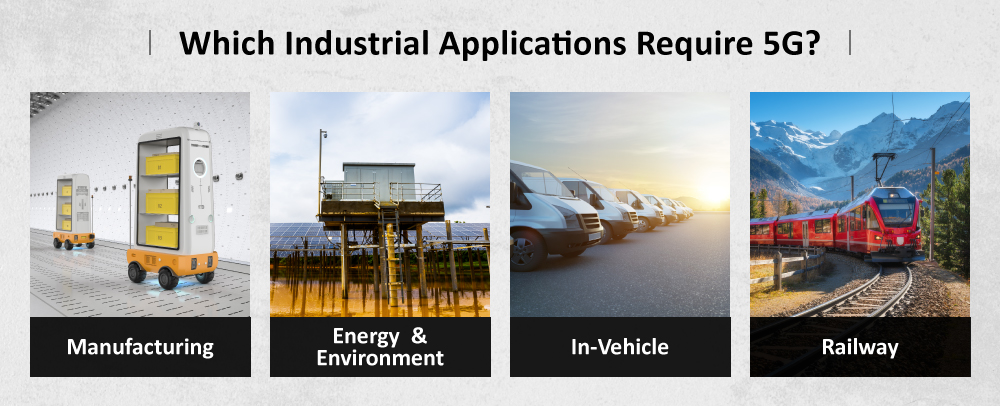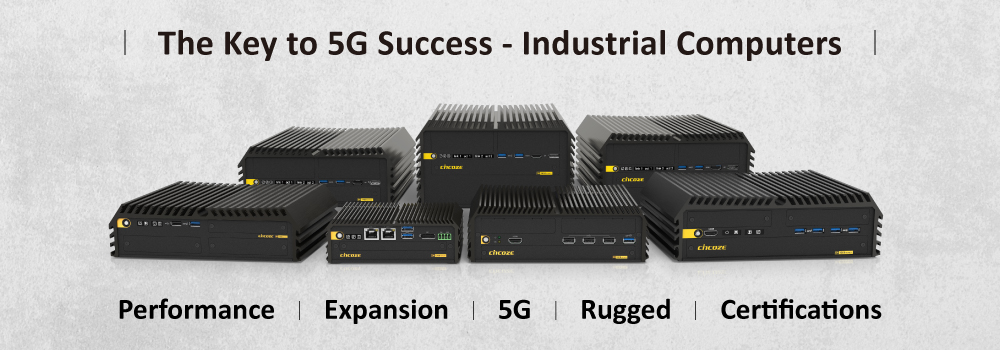
5G x Industry : Who needs it ? How to choose ?
When it comes to 5G, many people’s first reaction is “faster network speed”, but for industrial applications, 5G means much more than that. The three core features of 5G technology—Enhanced Mobile Broadband (eMBB), Ultra-Reliable Low Latency Communications (URLLC), and Massive Machine Type Communications (mMTC)—are bolstering the overall architecture and efficiency of production lines, equipment, and edge computing. 5G brings speed and industrial innovation! This article examines the industrial applications that can benefit from 5G and the role of industrial computer selection criteria.
We have Wi-Fi and 4G, why do we need 5G?
5G offers significantly improved stability and predictability compared to traditional 4G or Wi-Fi technologies. Wi-Fi, for example, is widely used in indoor places due to its ease of deployment; however, in factories with dense metal facilities, it is susceptible to interference, resulting in unstable connections or data delays. 4G networks often experience high latency and frequently switch base stations during device movement, which can impact data continuity and response speed.
5G has latency as low as 1 millisecond, which affects high-bandwidth transmission capabilities, making it particularly suitable for applications that require highly stable real-time transmission, such as autonomous mobile robots (AMRs), autonomous mining vehicles, and autonomous smart buses. At the same time, its large-scale device connection characteristics also enable future smart factories to integrate more sensors, machines, equipment, and remote platforms to form a true digital twin and edge intelligence architecture. 5G is not just a speed upgrade of communication technology; it is also a crucial foundation for promoting industrial digital transformation, enabling intelligent manufacturing and innovation in operational efficiency.

Which industrial applications require 5G?
With the development of 5G technology, more industries are beginning to introduce high-speed, low-latency, and large-scale connected wireless communication architectures. The following are the four industries with the greatest potential demand for 5G technology.
Manufacturing
In smart factories, equipment such as AGVs, AMRs, and mobile vision inspection systems must be able to move freely around the production line and stay connected to the network. 5G provides low latency, uninterrupted connections, and high bandwidth, solving the problems of complex wiring and unstable Wi-Fi, and providing stable and real-time communication support for mobile devices.
Energy and Environment
The remote location and harsh environments of wind farms, solar power plants, oil wells, river water level monitoring, or mountain environmental monitoring make cabling difficult. 5G’s wireless coverage can stably transmit data obtained by remote sensors and monitoring equipment, enabling real-time data feedback and effectively improving operational accuracy and efficiency.
In-vehicle
Road transportation and commercial fleet management increasingly rely on real-time monitoring, image streaming, and remote diagnostics. Combined with 5G, in-vehicle computers can support applications such as road image feedback, in-vehicle safety surveillance, driving behavior analysis, and passenger information systems (PIS). It can maintain stable communications even at high speeds, further enhancing driving safety and operational efficiency.
Railway
Typical applications in public transportation systems, such as train surveillance, AI safety identification, and passenger information systems, require stable and real-time data transmission. With its high-speed, low-latency data transmission, 5G can effectively address the issue of traditional wireless communication interruptions at high speeds, and comprehensively enhance driving safety and overall service quality.

The role of industrial computers in 5G applications
In the applications mentioned above, industrial computers are the indispensable common core. It is no longer just a simple computing platform, but also shoulders multiple tasks such as device connection, data processing, and stable communication.
Smart manufacturing: Computing and communication hub for mobility devices
In smart factories, AGVs and AMRs must receive instructions, send back data, and determine their routes in real time. Small, low-power industrial computers play an indispensable role in such applications, overcoming space limitations and reducing the need for frequent charging. With powerful computing performance and support for 5G modules, they can instantly judge information from sensors and cameras, adjust the path, and send back task results, accelerating equipment response and automated collaboration. We recommend the Entry Performance & Compact (DC Series) Fanless PCs for smart manufacturing applications.
Energy and environment: Remote monitoring nodes in distant locations
Industrial computers are ideal edge nodes in remote wind farms, solar plants, oil wells, and environmental monitoring sites, where laying out cables is difficult. Combined with 5G communications, they can receive sensor data in real-time, make judgments, issue alarms for abnormalities, and synchronize the data back to the remote control center. The rugged design can withstand harsh climates, support 24/7 long-term operation, reduce maintenance frequency, and enhance energy monitoring and environmental early warning capabilities. We recommend the High Performance & PCIe Expandable (DS Series) Fanless PCs for energy and environment applications.
In-vehicle applications: High-speed data processing platform
Industrial computers with wide temperature ranges, shock resistance, and low power consumption can maintain a stable connection during high-speed driving when paired with 5G, and perform applications such as real-time positioning, safety surveillance, and remote fleet management, effectively improving driving safety and operational efficiency. The built-in IGN function can further ensure system stability and data security. We recommend the Mid Performance & Power-saving (DI Series) Fanless PCs for in-vehicle applications.
Railway: Smart nodes inside trains and stations
Industrial computers overcome the space limitations and continuous vibration challenges on trains, and they have rich I/O interfaces to meet application requirements for safety surveillance and passenger information systems (PIDS). The front panel accessible hard drive design allows for quick access to key images in emergencies. Combined with 5G communications, it can instantly transmit images and train data to the train control center, which is crucial for improving operational efficiency and passenger experience in smart railway systems. We recommend the High Performance & Compact (DX Series) Fanless PCs for rail transportation applications.
3 key considerations when choosing a 5G industrial computer
A rugged, high-performance industrial computer is the best choice for 5G applications, but it is critical to keep the following three points in mind.
Module expansion and antenna design
When choosing an industrial computer, ensure it has an M.2 B Key expansion socket to support mainstream 5G communication modules, and that it is designed with independent antenna holes and sound RF isolation to minimize interference risks. Support for more than four antennas is recommended for 5G multi-band and MIMO architecture requirements, to optimize communication stability and overall transmission performance.
Electromagnetic protection
Electromagnetic compatibility (EMC) refers to the ability of electronic equipment to operate normally without generating electromagnetic interference (EMI) to surrounding devices, while also resisting external interference. EMC is an essential indicator of the stable operation of industrial computers. Recommended industrial computers pass or comply with relevant EMC test standards according to the application environment, such as EN 50121-3-2 for rail transportation, EN/IEC 61000-6-4/61000-6-2 for industrial environments, or E-mark certification for automotive applications.
Excellent heat dissipation
For high-performance industrial computers that integrate 5G communication functions, an excellent heat dissipation design is crucial for long-term stable operation. Each brand provides a variety of heat dissipation solutions. We recommend prioritizing models that support a wide temperature range (-40°C to 70°C). In addition, rugged features, such as cable-less and shock-resistant design, can further improve the reliability of applications in harsh environments.